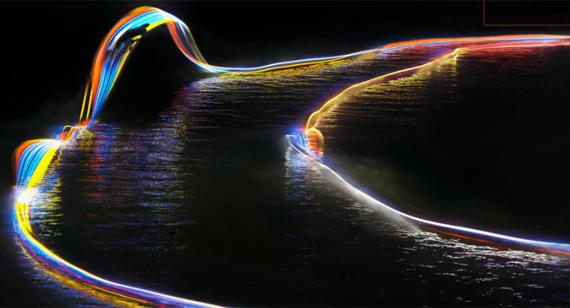We’ve discussed the concept of light painting before, but this video taken at the Orlando Watersports Complex brings the practice to a whole new level. Instead of premeditated shapes and patterns being drawn onto the image, photographer Patrick Rochon (in a project sponsored by Red Bull) attaches strip lights onto wakeboards and has athletes perform their maneuvers in the dark. This creates streaks and shapes that follow the incredible movements of the wakeboarders as they fly across the water’s surface, refracting colored rays through the spray at their feet. It all makes for stunning photographs of natural patterns of motion that arise from this aquatic sport:
Wakeboarding is a sort of cross between waterskiing and surfing, with elements of snowboarding and skateboarding mixed in. On a wide, relatively flat board, the wakeboarder stands and, grasping a handle, is towed by boat across the water’s surface (riding their board in the wake of the boat). While doing this, they can perform tricks off of various obstacles such as ramps and walls, springing through the air in jumps and flips, and a variety of other impressive feats.
To set up for this shoot, the team attached multicoloured strip lights around the edges and undersides of the boards themselves. They assembled the session at night, which imposed a challenge on the athletes to execute their craft with limited view of their obstacles—a difficulty which they conquer with ease. Most of the light is provided by the wakeboard lights, using long exposures of several seconds; often, they’ll fire a flash when the boarder is at the height of a jump, in order to freeze their image in the photograph. The camera is only shown in a deep silhouette, but they appear to be using a mid-range Nikon DSLR, most likely with a 70–200mm lens.
The result of all of this is some truly awesome pictures, with brilliant colors reflecting in the dark waters. The “let’s try this and see what happens” attitude is apparent, and it pays off with a marvelous visual map of the shapes and forms of this sport, creating beautiful works of art in one of the last places you might think to look for it.
Like This Article?
Don't Miss The Next One!
Join over 100,000 photographers of all experience levels who receive our free photography tips and articles to stay current:








Leave a Reply